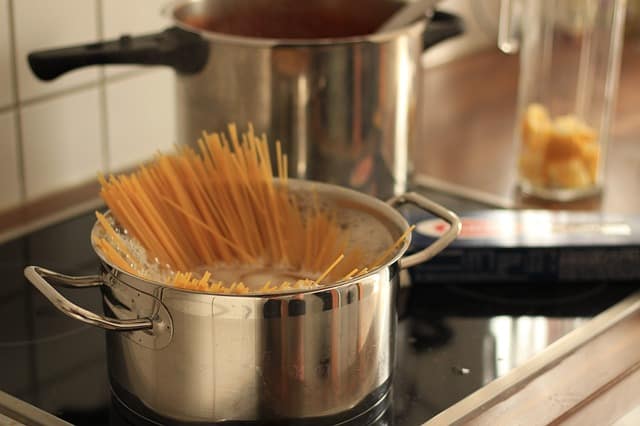It’s not easy to get around boiling your pasta noodles before introducing them to a tomato sauce. You could try just heating a large amount of sauce in a pan. Then stir in some noodles but this method would up taking much longer than boiling water.
The biggest issue is the amount of tomato sauce it would require. Because you would need to have the pasta submerged the whole time. You would also have to continuously stir them for a long time.
I would use smaller pasta noodles instead of traditional spaghetti noodles. As they with fit better in the pan and cook faster.
The best approach is to cook pasta in water then Tomato sauce in a separate pan. Bring sauce to a gentle boil, after pasta is done. Strain noodles but keep some of the water (optional). Then combine the noodles to the sauce pan. Continue cooking them together for a couple minutes. Add some of the water back in add the end (optional).
This method of combining the sauce and noodles towards the end. Is not much different than the common way of cooking them.
How To Cook Pasta In Tomato Sauce (Step-By-Step)
- Start the same way as before. Begin cooking the pasta noodles in water. First start boiling some water (add some salt to the water). Once it is boiling then add the pasta.
- Add the sauce to a pan and start to bring it up to heat. The sauce should have been heating slowly while the water was coming to a boil. This works best because the noodles do not take as long.
- When the noodles are done and the sauce is simmering still. Put the noodles into the pan with the sauce .
- (Optional) Save a little bit of the water used for boiling the pasta. You don’t need much only about 1-2 TBSP. You can use this starchy water to thicken the sauce later and help it stick to the noodles.
- Continue to cook them on lower heat for a couple minutes. Stir them together and add additional ingredients if needed. You can add butter, olive oil or herbs and spices. Serve the pasta together after combining for a couple minutes.
General Rules for Boiling Pasta Noodles
- Do not add oil to the water you boil pasta in.
- This stops the sauce from sticking to the noodles properly
- Do not rinse the pasta after cooking
- Doing this removes starch that also helps sauce stick to noodles, and it can cool off the noodles to quickly. You don’t want to add fresh water, the water that is has been cooked in works best.
- Don’t dump all the water down the drain
- You might want to add some additional starchy water, it helps the sauce thicken and the two to combine better.
- Use the right amount of water
- The ratio of water to pasta is crucial. On most noodle packages, it will instruct. For every pound of pasta use 4 – 6 quarts of water. 4 quarts equals 16 cups of water. 4 quarts is also equal to 128 fluid oz.
- Don’t Just Mix any noodle type with any sauce
- You want to use the right sauce with the right noodle. Thin noodles use thin lighter sauce. For bigger noodles use thicker sauce. Noodle shapes with holes or big spaces use chunkier sauces.
- Do not add the noodles too soon
- Wait for the water to come to a complete boil. Other wise the noodles become soggy.
- Do not test spaghetti by seeing if it sticks on something
- This is a common myth, you can do it for fun or a prank. But there is nothing to show that this means the noodles are done. You will only end up with a dirty fridge or wall.
Cooking Pasta In The Sauce Using One Pan
The other methods of cooking similar to this is with making lasagna. Usually the recipe calls for precooking the noodles half way. Then when you go to bake it the noodle will finish cooking.
This is hard to get just right, especially the very top noodles. As they tend to get over cooked. Try soaking them in water first for about 15 – 20 minutes.
You can also use a skillet to cook pasta and sauce together. By heating the sauce in a skillet, the sauce heats up more evenly. You can cook noodles in boiling water first, then add them to a skillet with the sauce already heated.
Italian Pasta Terms
- Al dente: Means pasta that has been cooked and is properly done. The pasta is done just right. Firm noodles instead of soft.
- Molto al dente: Means under cooked pasta noodles.

